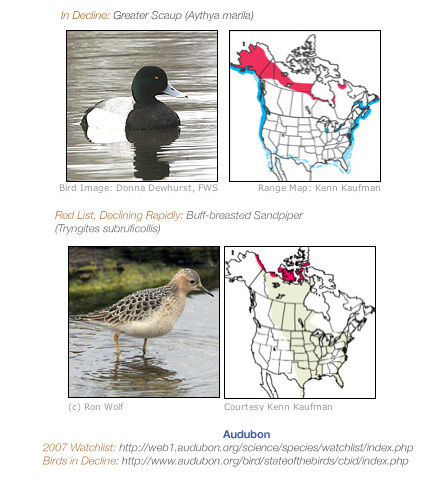2007 Watchlist from Audubon Identifies Birds at Risk in North America and Hawaii
by admin ~ December 1st, 2007

Drawing on new data and first hand observation from citizen birders in U.S. and Canada, Audubon issues a watchlist for 2007 and highlights birds in rapid decline, and in some cases near extinction. “Identifying the species at greatest risk is the first step toward saving them. It helps target public policies, funding support, conservation initiatives and public commitment on the species and habitats that need it most” (1).
The initiative is a partnership between Audubon and the American Bird Conservancy, and identifies “178 species in the continental U.S. and 39 in Hawaii that are in need of immediate conservation help.” This represents an increase of 10% from 2002 (2). The list includes a red category for species of greatest concern, and a yellow category for species that are declining or rare. The watchlist adds to a June 2007 report from Audubon, Common Birds In Decline, which combines data from Audubon’s century-old Christmas Bird Count program and the annual Bird Breeding data by the U.S. Geological Survey. The information is regularly submitted for peer science review.
Among the major habitat and environmental challenges facing birds on the list include: suburban sprawl, other habitat loss, industrial farming, pesticide use, oil and gas development, forestry practices, invasive species, pollution, and climate change (particularly the threats of rising sea levels in coastal breeding and feeding areas, disappearing salt marshes, glacial retreat, and melting permafrost):
The wide variety of birds affected is reason for concern. Populations of meadowlarks and other farmland birds are diving because of suburban sprawl, industrial development, and the intensification of farming over the past 50 years.
Greater Scaup and other tundra-breeding birds are succumbing to dramatic changes to their breeding habitat as the permafrost melts earlier and more temperate predators move north in a likely response to global warming. Boreal forest birds like the Boreal Chickadee face deforestation from increased insect outbreaks and fire, as well as excessive logging, drilling, and mining (3).
Several news stories profile northern species in Alaska that appear on the list (see below). Alaskan birds on the red list include: the steller’s eider, spectacled eider, sooty grouse, laysan albatross, black-footed albatross, short-tailed albatross, pink-footed shearwater, eskimo curlew, rock sandpiper, buff-breasted sandpiper, ivory gull, and kittlitz’s murrelet (Far North Science). Each year, there are numerous submissions to the Christmas Bird Count from citizen birders around the North: Alaska, Yukon, Northwest Territories, Nunavut. Click here to learn more about how to get involved.
More information:
- Audubon: 2007 Watchlist (November 2007), Common Birds in Decline (June 2007).
- New York Times: “Millions of Missing Birds, Vanishing in Plain Sight” (June 2007), “A Rising Number of Birds at Risk” (Dec. 1, 2007), “Editorial: Endangered Species” (Dec. 1, 2007).
- Canada in Spotlight: “Third of Species on New Watchlist of At-risk birds are Canadian” (Boreal Songbird Initiative).
- Alaska in Spotlight: “Alaskan Birds in Jeopardy” (Far North Science), “Small Alaska Bird in Big Trouble” (Anchorage Daily News), “Kittlitz’s Murrelet” (Center for Biological Diversity), “Alaska Birds Included on National Watch List” (Alaska Public Radio Network). You can listen to the APRN report below.
.jpg)